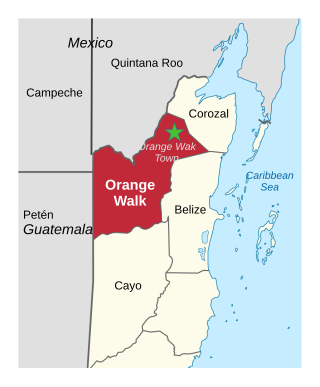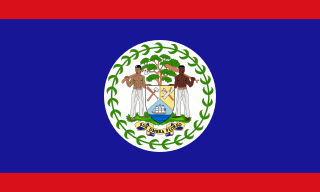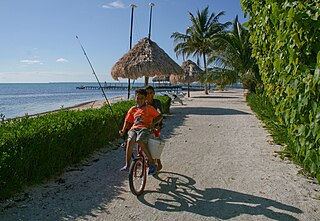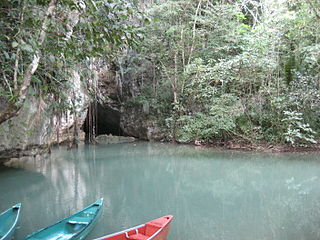
Orange Walk Town is the fourth largest town in Belize, with a population of about 13,400. It is the capital of the Orange Walk District. Orange Walk Town is located on the left bank of the New River, 53 miles (85 km) north of Belize City and 30 miles (48 km) south of Corozal Town. Despite the English name of the city, its residents are primarily Spanish-speaking mestizos.

Orange Walk District is a district in the northwest of the nation of Belize, with its district capital in Orange Walk Town.
Guinea Grass is a village in the Orange Walk District of the nation of Belize. It is 38 metres above sea level. According to the 2000 census, Guinea Grass had a population of 2,510 people; by 2010 the census figures showed a population of 3,500. The population is made up of mostly Mestizos, Creoles, and East Indians. There are a number of Mennonites, Taiwanese and other Central American immigrants living near or immediately in the village.
Little Belize is a colony of conservative Plautdietsch-speaking "Russian" Mennonites, known as "Old Colony Mennonites", in the Corozal District of Belize. It is part of the Corozal South East constituency. Little Belize is located east of Progresso at an elevation of 1 meter above sea level. Because the Mennonite colony is close to Progresso, it is sometimes called "Progresso".

Shipyard, also called Shipyard Colony, is a Mennonite settlement that is also an administrative village in the Orange Walk District of Belize.

The major languages spoken in Belize include English, Spanish and Kriol, all three spoken by more than 40% of the population. Mayan languages are also spoken in certain areas, as well as German.

Christianity is the dominant religion in Belize. The single largest denomination is the Catholic Church with about 40.1% of the population, a reduction from 49.6% of the population in 2000, 57.7% in 1991 and 61.9% in 1980, although absolute numbers have still risen. Other major groups include Pentecostal with 8.4% of the population up from 7.4% in 2000 and 6.3% in 1991, Seventh-day Adventists with 5.4% of the population up from 5.2% in 2000 and 4.1% in 1991. The following of the Anglican Church has been steadily declining, with only 4.7% of the population in 2010 compared to 6.95% in 1991. About 12,000 Mennonites live mostly in the rural districts of Cayo and Orange Walk. People who declared they belong to no religion make up 15.5% of the population in 2010, more than double their 2000 census numbers. 11.2% adhere to other religions which include the Maya religion, Afro-Caribbean religions, Mormons, Hindus, Buddhists, Muslims, Baháʼís, Rastafarians and others.

Mennonites in Belize form different religious bodies and come from different ethnic backgrounds. There are groups of Mennonites living in Belize who are quite traditional and conservative, while others have modernized to various degrees.
Kleine Gemeinde is a Mennonite denomination founded in 1812 by Klaas Reimer in the Russian Empire. The current group primarily consists of Plautdietsch-speaking Russian Mennonites in Belize, Mexico and Bolivia, as well as a small presence in Canada and the United States. In 2015 it had some 5,400 baptized members. Most of its Canadian congregations diverged from the others over the latter half of the 20th century and are now called the Evangelical Mennonite Conference.
Belize Evangelical Mennonite Church is a church denomination of the Fellowship of Evangelical Bible Churches in Belize.

Hispanic and Latin American Belizeans are Belizeans of full or partial Hispanic and Latin American descent. Currently, they account for around 52.9% of Belize's population.
Old Colony Mennonites are a part of the Russian Mennonite movement that descends from colonists who migrated from the Chortitza Colony in modern Ukraine near Zaporizhia to settlements in Canada. Theologically, Old Colony Mennonites are largely conservative Mennonites.

Barton Creek is the name of a small river and the area it flows through in Cayo District, Belize. The river is a right tributary of Belize River. In the area with this name there are two Mennonite settlements: Lower and Upper Barton Creek. Both are settlements of very conservative Mennonites in Belize. Barton Creek Cave can also be found here.
Springfield is a Mennonite village in Cayo District, Belize, some 15 km south of the capital Belmopan.
Upper Barton Creek is a mixed Mennonite settlement and expats in Cayo District in Belize in the area of the Barton Creek. The Mennonites in Upper Barton Creek are ethnic Mennonites of the Noah Hoover group.
Pilgrimage Valley is a small Mennonite settlement in Cayo District, Belize, some 5 km east of San Ignacio.
Pine Hill is a Mennonite village in Toledo District, Belize, some 15 km north of the district capital Punta Gorda.
Indian Creek is a Mennonite settlement that is also an administrative village in Orange Walk District in Belize. Its inhabitants are German-speaking so called "Russian" Mennonites.
Blue Creek, also Blue Creek Colony, is a Mennonite settlement that is also an administrative village in Orange Walk District in Belize. It borders Blue Creek river, which forms the border to Mexico. Its inhabitants are Plautdietsch-speaking Russian Mennonites.








